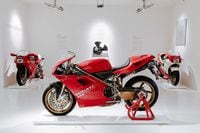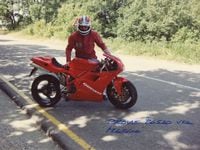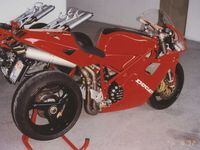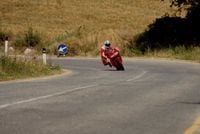The Ducati 916 is regarded as one of the most beautiful motorcycles ever created, becoming an instant icon when it was introduced in 1994. Its stance and proportions are perfection, even 25 years after we were first stunned by its Italian sexyness.
The venerated 916 ushered in a new era for Ducati, helping transform the brand from a small player into a company that produces lust worthy sportbikes, akin perhaps to the Ferrari of motorcycles. Superbike championships quickly followed, cementing the bike’s legendary status.
Now we have an intriguing glimpse into an early chapter of the 916 story, the Ducati 916 used personally by Massimo Tamburini in the model’s development. Tamburini (1943–2014) was the revered designer of the 916 as well as a co-founder of Bimota, and he later went on to author the gorgeous MV Agusta F4.
The 916 in these photos is supposedly one of just three prototypes Tamburini used to develop the bike on the roads around Ducati’s Borgo Panigale factory, and the nearby Mugello and Misano racetracks.
There are several components on the bike that make it stand apart from production 916s. The gauges are notable for their absence of a speedometer, being fitted with only a tachometer and a water temperature indicator. No turn signals, either.
“The bike is almost completely made of fiberglass,” reads a Ducati press release, “while the air conveyors, front mudguard, airbox, tailpipes and number plate holder are made of carbon fiber.”
The bike also features a few other trick bits. Those tasty magnesium wheels and swingarm were likely added after final development, as were the Öhlins fork and shock.
The 916’s basic design endured through 996 and 998 iterations until 2003. Eight years was an eternity in sportbike development at the time. The 999 that followed, penned by Pierre Terblanche, was roundly criticized for being ugly in comparison to the stunning 916/998 even though it was actually a better motorcycle.
We can thank Tamburini for bringing the 916 into the motorcycle lexicon, and it’s difficult to imagine our world without the sultry 916 in it.
















/cloudfront-us-east-1.images.arcpublishing.com/octane/MUQLOVLL2ZDGFH25ILABNBXKTI.jpg)
/cloudfront-us-east-1.images.arcpublishing.com/octane/TNOU5DNE2BC57MFPMGN2EIDXAM.jpg)
/cloudfront-us-east-1.images.arcpublishing.com/octane/GTCXACQGJ5HAPDTGWUQKDEH44E.jpg)
/cloudfront-us-east-1.images.arcpublishing.com/octane/S35YGSEMEZB4BLTDJTSZPF4GLA.jpg)
/cloudfront-us-east-1.images.arcpublishing.com/octane/5UOT6HPX2JFMRJAX6EH45AR4MQ.jpg)
/cloudfront-us-east-1.images.arcpublishing.com/octane/OKWOJWAKP5EP3OACCRRWPCIX2Q.jpg)
/cloudfront-us-east-1.images.arcpublishing.com/octane/2WF3SCE3NFBQXLDNJM7KMXA45E.jpg)
/cloudfront-us-east-1.images.arcpublishing.com/octane/G4MG6OUCJNBSHIS2MVVOTPX65E.jpg)
/cloudfront-us-east-1.images.arcpublishing.com/octane/IIGGWFOTOJGB7DB6DGBXCCMTDY.jpg)
/cloudfront-us-east-1.images.arcpublishing.com/octane/QSTCM6AVEZA5JJBUXNIQ3DSOF4.jpg)
/cloudfront-us-east-1.images.arcpublishing.com/octane/U4I7G625B5DMLF2DVIJDFZVV6M.jpg)
/cloudfront-us-east-1.images.arcpublishing.com/octane/B6XD6LS6IVCQPIU6HXDJSM3FHY.jpg)
/cloudfront-us-east-1.images.arcpublishing.com/octane/ICL63FEDDRDTTMINYICCEYGMDA.jpg)
/cloudfront-us-east-1.images.arcpublishing.com/octane/FCGZHQXRBZFLBAPC5SDIQLVF4I.jpg)
/cloudfront-us-east-1.images.arcpublishing.com/octane/WNOB6LDOIFFHJKPSVIWDYUGOPM.jpg)

/cloudfront-us-east-1.images.arcpublishing.com/octane/X33NU3E525ECRHXLNUJN2FTRKI.jpg)
/cloudfront-us-east-1.images.arcpublishing.com/octane/6KKT5NNL2JAVBOXMZYS5ZO76YA.jpg)
/cloudfront-us-east-1.images.arcpublishing.com/octane/J5RKG5O455GMPGQRF2OG6LRT7A.jpg)
/cloudfront-us-east-1.images.arcpublishing.com/octane/GX2CIZKQVRH2TATDM26KFG2DAE.jpg)
/cloudfront-us-east-1.images.arcpublishing.com/octane/ZWIDYSAKQZHD5BHREMQILXJCGM.jpg)
/cloudfront-us-east-1.images.arcpublishing.com/octane/CYUHJZCTSJCH3MRAQEIKXK7SCQ.jpg)
/cloudfront-us-east-1.images.arcpublishing.com/octane/LKOFINY56FCXJCANJ5M7ZDQUBY.jpg)
/cloudfront-us-east-1.images.arcpublishing.com/octane/4NBPDACMWJH63JQYJVK3QRBDZI.jpg)